Family : Muscicapidae

Text © Dr. Gianfranco Colombo

English translation by Mario Beltramini

Robi (Erithacus rubecula). Hunger chases the wolf from the wood and in winter also the robin goes down in the valley or to latitudes with milder climate looking for food © Gianfranco Colombo
All the countries of the world have their national bird, from the remote Kingdom of Bhutan that has indicated the Common raven (Corvus corax) to the better known Bald eagle (Haliaeetus leucocephalus) of the United States of America or the very coloured Grey crowned crane of Uganda (Balearica regulorum) even represented in the national flag or to the Lesser bird-of-paradise (Paradisaea minor) of Papua New Guinea.
In this symbol some have tried to represent the beauty of the chosen animal, others the endemicity of a species not present in any other part of the world but more often simply an affinity of the character of the favourite subject, with that typical of the people to represent.
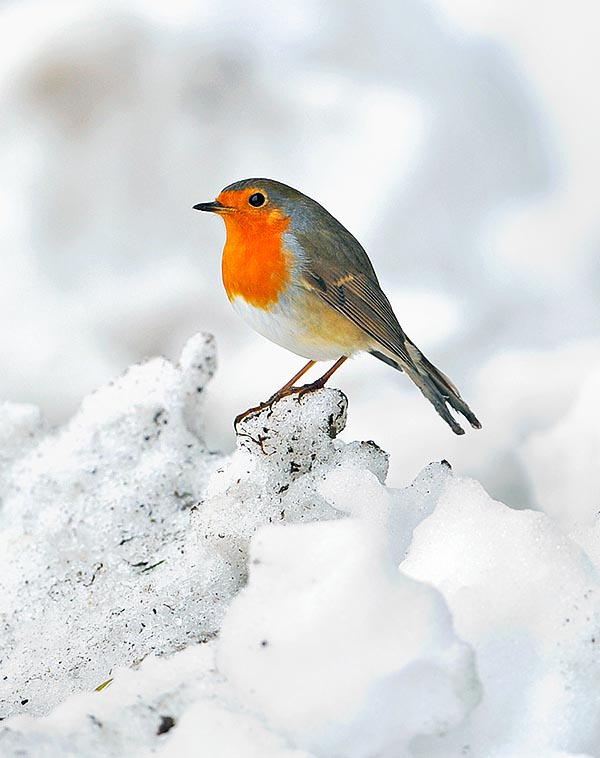
It is easy to see it, especially after a snowfall, cold and without shelter © Gianfranco Colombo
The Robin (Erithacus rubecula Linnaeus, 1758) belongs to the order of the Passeriformes and to the family of the Muscicapidae and is one of the most common birds in Europe. In an estimation done in the beginning of the century, they indicated in about 120 millions the number of the couples nesting in its range, value still now realistic.
Perhaps it is docile and friendly on the British soil but by sure in continental Europe it does not always prove to be so kind as it is usually described, nor even so amiable towards its consimilars.
In most of the year in our countries it is an absolutely shy and reserved bird, elusive and immediately ready to throw itself into a thick bush to shelter from the prying eyes of the humans.
Conversely, in winter part of the population becomes more social and docile and adapts to human habits in order to survive to the hardships of the bad season. Here it is, then, occupying part of the house garden where however it hardly applies the right to property against anyone trying to occupy its territory. Every individual, male or female, drives away evilly the house sparrows (Passer domesticus), the blackbirds (Turdus merula), the tits (Parus spp.) the powerful collared doves (Streptopelia decaocto) and even its similars, with an unimaginable cruelty.
Just put in the middle of its territory a decoy of a similar and here it is immediately attacking it furiously and pouncing violently on it, pecking its eyes, hitting it on the head and ripping its feathers. Such a dear and docile small bird that practically becomes, with bloody actions, a murderous hyena in order to keep the dominion over its own territory. Then, once April has come, it suddenly and without any notice disappears from our garden and takes shelter again in the shady environment, dark and reserved of a dense hardwood or conifers forest.
Many are the popular traditions that accompany this bird often linked to the red spot on the chest that nature has placed.
Common in many Christian/Catholic countries, the tradition indicates this purplish spot as the mark left by a drop of the blood of the Crucified Christ, left while the small bird was taking off a spine from His head.
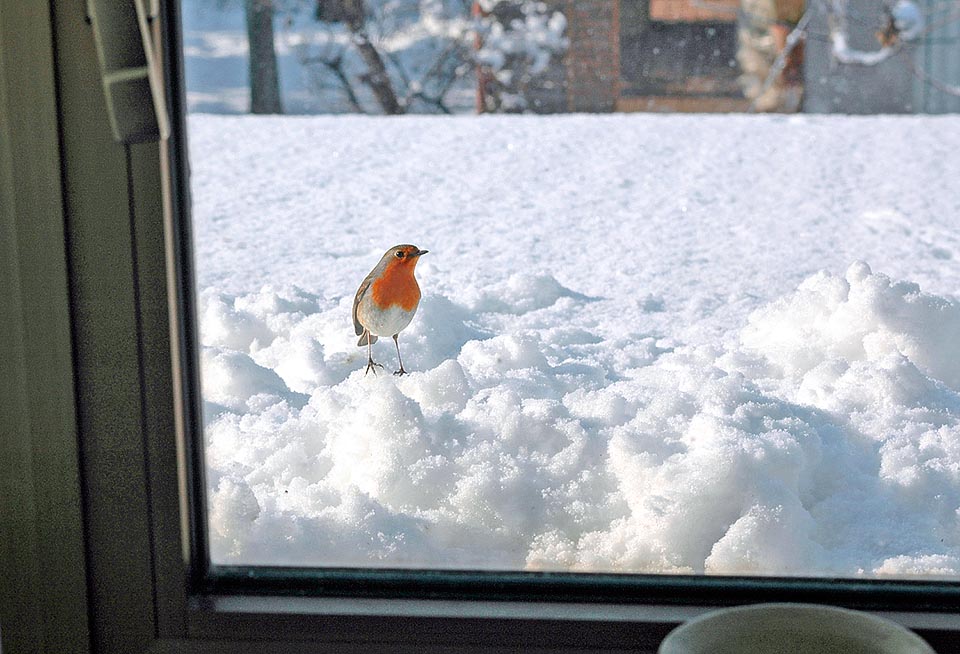
Has lost the innate caution. Doesn’t flee any more man and gets opportunist, competing with blackbirds, sparrows and other domestic birds it attacks jealous, violently © Gianfranco Colombo
But the traditions are many and often linked to its seasonal presence chronometrically timed, where its disappearance or death is compared to the change of seasons and to the rebirth of life.
In a quite famous rhyme known by all English children, is recited metaphorically the death of the robin, to which participate all the birds of the wood. Of very ancient origin and with multiple interpretations, it might be connected to Medieval political facts but more practically and suggestively to the prevailing of the nice season on the winter.
That is how in the rhyme Who killed Cock Robin? we see parading from the sparrow to the owl, from the crow to the skylark, from the linnet to the dove, from the kite to the wren to end with the bullfinch that with its great bill tolls the bells in memory of the death of Cock Robin, metaphorically, the winter.
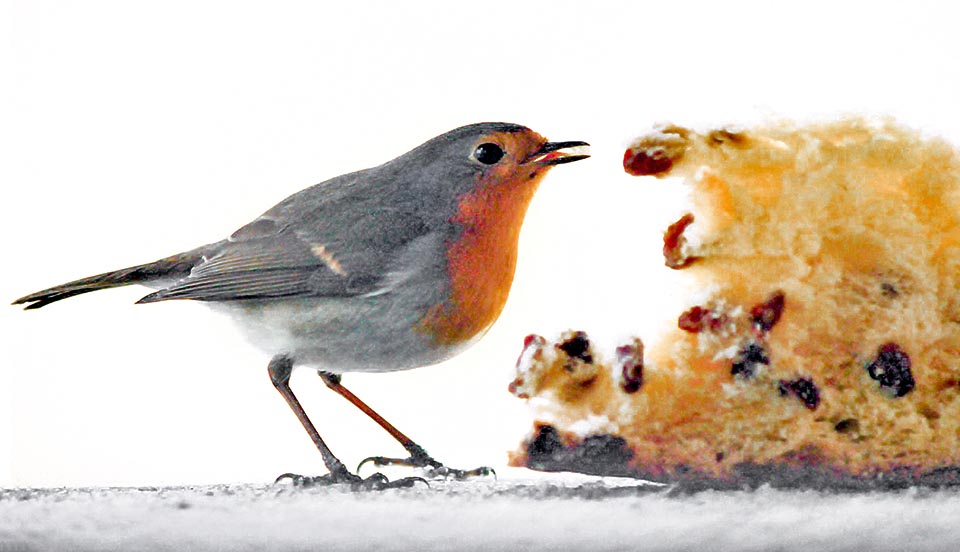
At Christmas a slice of cake on the window sill is the best also for an insectivore that in the bad season transforms partially in frugivorous, looking for the last left berries, seeds and rotting fruits. Now often begs for bread, crumbles of cheese and even, when it happens, more caloric and gluttonous sweet scraps © Agostino Codazzi
Robin is the nickname given in UK to the robin readbreast, the same name the North Americans there installed in the past centuries, gave to their American robin, a big turdid with reddish chest (Turdus migratorius), maybe as per nostalgia of their robin that was missing there.
The etymology of the scientific name gets origin from an ancient tradition, anticipated by Aristotle but also partially sustained by Linnaeus and that lasted till when they did fully understand the concept of migration, that saw summer birds transforming in other similar species in winter.

High on a pole, this Erithacus rubecula surveys its farmer, ready to dive on the first worm surfacing in the field or from a furrow of the fields plowing © Gianfranco Colombo
The species rubecula from the combination of the two Latin terms “rubeus” = bramble and “cola” = inhabitant, rightly for the environment usually frequented.
It is also interesting the etymology of the scientific name of the family Muscicapidae that comes from the Latin “musca” = fly and “capere” = to catch.
In English European Robin, in German Rotkehlchen, in Spanish, Petirrojo europeo, in French Rougegorge familier, in Italian Pettirosso and in Portuguese Pisco-de-peito-ruivo.
Zoogeography
The robin occupies totally Europe up to very high latitudes missing only in the extreme north of the Scandinavian peninsula and in Iceland. In Asia, it lives in most of Siberia indicatively north of the 50th parallel getting to touch Mongolia whilst in the Middle East occupies permanently the area around the Black Sea going down up to Iran and the Persian Gulf and the Mediterranean coast. It is present also on all African Mediterranean coast with a good population in Algeria and Morocco and also the Atlantic islands of the so-called Macaronesia (Madeira, Canaries and Açores).
Various subspecies have been classified among which the most important for Europe are the Erithacus rubecula rubecula typically of continental Europe up to Urals and Asia Minor and the Erithacus rubecula melophilus of the British Isles. More detailed research has however identified inside these populations, other subspecies with minor morphological variations, therefore the number of these new classifications is continuously growing.
Ecology-Habitat
The robin is a bird living in the thick and dense woods, mainly of broad-leaved trees, disseminated with a thick underwood, formed by old trees wrapped by lianas and climbing ivies, humid and little luminous. In this environment it practically eludes the view in its movements for the camouflaging colour of its livery and much more for the lack of light.
In central-northern Europe it lives also in gardens and public parks that must have, however, bushes and brambles inside which it may easily find shelter. It is easier to feel its presence than to observe it directly, because, as soon as it feels a danger, it sneaks into some bush or keeps apart on a low leafy branch and emits its warning clatter. Nevertheless, during the first hours of the morning it conversely loves lurking conspicuously and kissed by the early sun on a dry sprig or on a well-exposed support where it emits its melodious song to indicate that right to property that is even exasperated during the occupation of the winter territory.

This one, luckier, winters like the rich of the “Belle Époque” in the Monte Carlo Casino gardens. With all passing tourists the food here never misses and some are late more than the standard. Maybe they become sedentary and reproduce in the Principality, seen that by late May they are there pecking under the roses in bloom © Giuseppe Mazza
In winter the contact with the human beings becomes assiduous and perhaps necessary for many of them who feel, besides protected also helped by the availability of food to survive to the rigors of the bad season.
Morpho-physiology
The robin was once classified in the family of the Turdidae and is the only species in its genus.
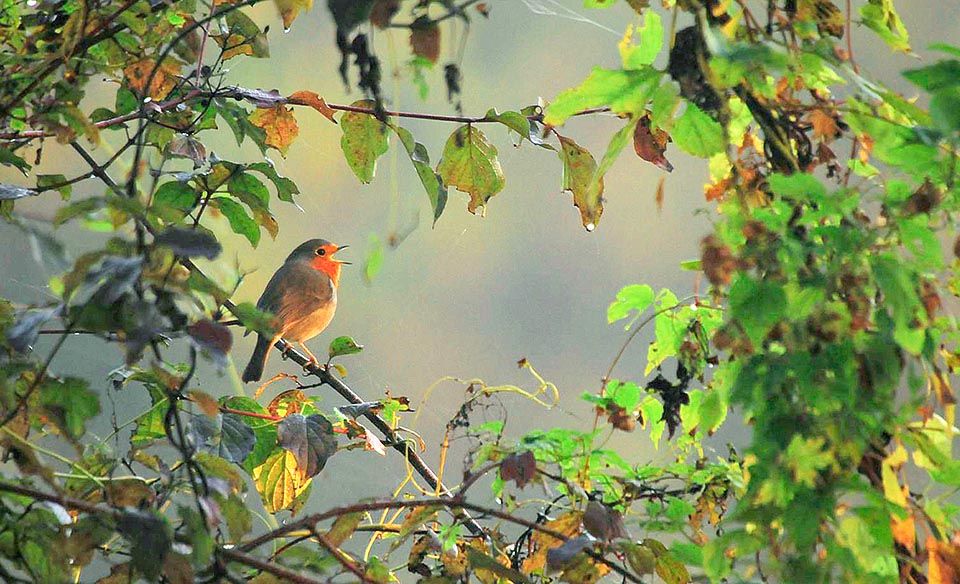
In April in fact, usually, the robin gets back to its humid wood, rich of insects, to reproduce and then it's easier to hear it singing than to see it © Fabio Severgnini
The prevailing colour of the livery is the olive grey covering completely the back, from the head to the tail, leaving instead the body and the abdomen that are of a little significant opaque cream white. Main evidence of its plumage is the reddish spot on the throat that goes up to mid-chest and that is a constant presence in the male as well as in the female in all seasonal liveries. In fact, there is no sign at all of difference between the sexes, perhaps facilitating that behaviour of exasperated territoriality shown indifferently by the two sexes during the winter. The young have a livery completely different than the adults with a brownish plumage spotted yellowish.

The males quickly choose their new territory and a partner for reproducing © Gianfranco Colombo
It has short, wide and stubby wings not suitable for the real migration, however this small bird sometimes undertakes autumn displacements towards more welcoming areas that may be likened to a real migration. Sedentary in very many areas of its territory, is instead subjected to altitudinal displacements that see it reaching the bottoms of the valleys during the bad season, even covering distances of over 100 km or to leave areas subjected to rigid winter temperatures for others with a milder climate. The Mediterranean area is one of the most frequently chosen for these seasonal wanderings.
During the winter their presence can create overcrowdings in the wintering sites, problem that is surely at the base of that particular aggressive behavior we were previously talking of.
It stands among the few birds that emits its song all over the year.
Ethology-Reproductive Biology
The robin is a good reproducer that is able to accomplish even two broods per year.
It is quick in choosing the territory and the partner because often gets on the spot already coupled or at least it finds the partner in very few days from the arrival and begins quickly the nidification. This happens in the year where the spring temperature increases rapidly and frees the territory occupied by the snow coverage and in couples in very good status of health. The nest is fairly hidden and is not easy to discover. It can be found on the ground between the big roots of an old tree, or in a recess on the ground al the base of trunk or also in holes of trees or simply under a stone slightly raised. It places it also over the level of the soil hidden in a wild ivy clung to a tree or on a low bush well ramified but always at trivial heights. In some instances it has built it also inside of artifacts left abandoned by man such as empty cans, boxes or recesses in abandoned agricultural machines.
The nest is a perfect cup, deep and composed by moss, lichens dry grasses and leaves where are laid 5 to 6 whitish eggs with scattered and fine dottings of reddish colour. The brooding, pertaining exclusively to the female, lasts about two weeks and the small nestlings come to life completely featherless.Shortly, a light down will grow up and this will be replaced during the following fifteen days by a complete plumage.
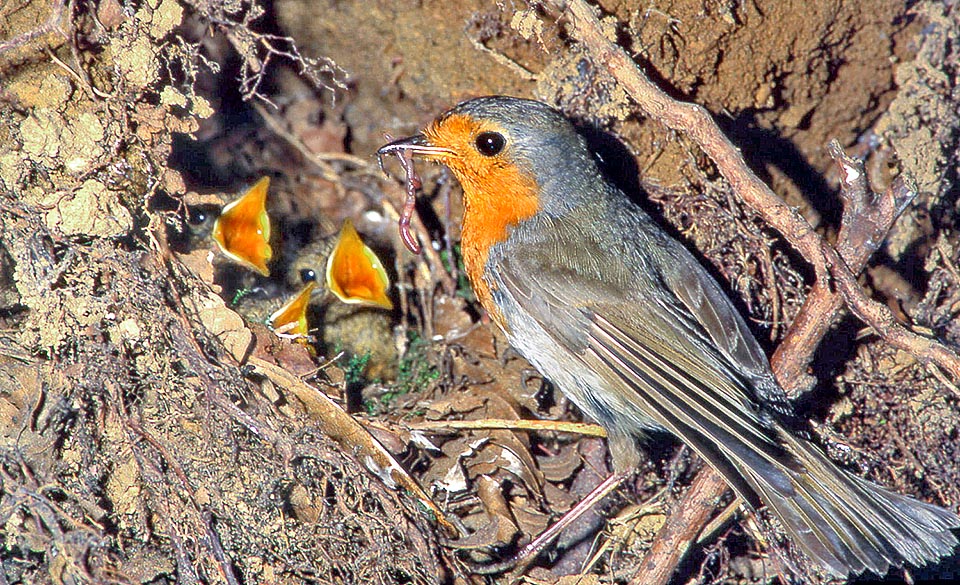
The females care even two broods per year helped by the male who follows the chicks by two weeks before the beginning of the second cycle © Museo Civico di Lentate
The feeding of the robin varies during the seasons. In the nidifications periods the food is mainly insectivorous, rich of proteins and suitable to a quick and healthy growth of a numerous progeny. It is a waiting bird that stands on a low small branch observing with care anything that moves at its feet to catch it without any hesitation.

The poullets, with a livery quite different from the adults, in fact take big risks as they disperse, abandoning the nest, when they are still unable to fly © G. Colombo
In winter it becomes partially frugivorous and eats the berries remained on the branches, small seeds and rotting fruits but does not fail to peck out of the front door, bread, cheese crumbs and even more, crubs of cakes of which is particularly greedy. In Lombardy the crumbs of the Milanese sweet cake Panettone are its preferred. It is sufficient a little of sultanas and sweetish small pieces thrown on the window sill to see it appearing, as one of the family, to celebrate the Holy Christmas.
Synonyms
Motacilla rubecula Linnaeus, 1758.
→ To appreciate the biodiversity within PASSERIFORMES please click here.
